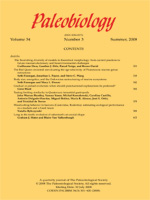The processes of fossilization have usually been perceived by paleontologists as destructive ones, leading to consecutive (and in most cases irretrievable) losses of paleobiological information. However, recent developments of conceptual issues and methodological approaches have revealed that the decrease in paleobiological information runs parallel to the gain of taphonomic information. This taphonomic imprinting often makes it possible to decode the fraction of paleobiological information that was lost during fossilization, and may also contribute new data for deciphering paleobiological information that was not originally preserved in the assemblage, such as paleoethology. A good example is the study of the macrovertebrate assemblage from the lower Pleistocene site at Venta Micena (Orce, southeastern Spain). Taphonomic analysis showed that the giant, short-faced hyenas (Pachycrocuta brevirostris) selectively transported ungulate carcasses and body parts to their maternity dens as a function of the mass of the ungulates scavenged. The fracturing of major limb bones in the dens was also highly selective, correlating with marrow content and mineral density. Important differences in bone-cracking intensity were related to which species the bones came from, which in turn biased the composition of the bone assemblage. The analysis of mortality patterns deduced for ungulate species from juvenile/adult proportions revealed that most skeletal remains were scavenged by the hyenas from carcasses of animals hunted by hypercarnivores, such as saber-tooths and wild dogs. Analytical study of the Venta Micena assemblage has unlocked paleobiological information that was lost during its taphonomic history, and has even provided paleobiological information that was not preserved in the original bone assemblage, such as the paleoethology of P. brevirostris, which differed substantially from modern hyenas in being a strict scavenger of the prey hunted by other carnivores.
How to translate text using browser tools
1 September 2001
Taphonomic decoding of the paleobiological information locked in a lower Pleistocene assemblage of large mammals
Paul Palmqvist,
Alfonso Arribas
ACCESS THE FULL ARTICLE

Paleobiology
Vol. 27 • No. 3
September 2001
Vol. 27 • No. 3
September 2001




